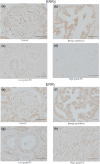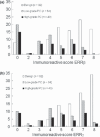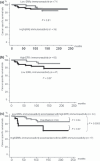Differential expression of estrogen-related receptors beta and gamma (ERRbeta and ERRgamma) and their clinical significance in human prostate cancer
- PMID: 20128821
- PMCID: PMC11158660
- DOI: 10.1111/j.1349-7006.2009.01451.x
Differential expression of estrogen-related receptors beta and gamma (ERRbeta and ERRgamma) and their clinical significance in human prostate cancer
Abstract
Estrogen-related receptor (ERR) is a nuclear receptor that modulates the estrogen-signaling pathway. Here, we investigated the expression of both ERRbeta and ERRgamma in human prostate tissues. Using original rabbit polyclonal anti-ERRbeta and anti-ERRgamma antibodies, the expression of ERRbeta and ERRgamma was evaluated by immunohistochemical analysis of cancerous lesions (n = 107) and benign foci (n = 92), obtained by radical prostatectomy. Stained slides were evaluated for the proportion of immunoreactive cells and their staining intensity. Total immunoreactivity scores (IR scores; range, 0-8) were calculated as the sum of the proportion and intensity scores. The relationship between the clinicopathological characteristics of the patients and the expression of the three ERRs (ERRalpha, ERR beta, and ERR gamma) was evaluated. IR scores for ERRbeta and ERRgamma were significantly lower in cancerous lesions than that in benign foci (P < 0.0001, for both). Clinicopathological analyses revealed that the patients with low ERRgamma IR scores (<or=4) tended to show poor cancer-specific survival (P = 0.07). Then, we used data from our previous study (Fujimura T., Int J Cancer, 2007; 120: 2325-30). Patients with a high IR score for ERRalpha and a low score for ERRgamma showed significantly poorer cancer-specific survival than those with a low IR score for ERRalpha and a high score for ERRgamma (P = 0.0003). We demonstrated the differential expression of ERRbeta and ERRgamma in prostate tissue. The combined evaluation of the expression of ERRalpha and ERRgamma could be a significant prognostic factor for prostate cancer.
Figures




Similar articles
-
Estrogen-related receptors alpha, beta and gamma expression and function is associated with transcriptional repressor EZH2 in breast carcinoma.BMC Cancer. 2018 Jun 26;18(1):690. doi: 10.1186/s12885-018-4586-0. BMC Cancer. 2018. PMID: 29940916 Free PMC article.
-
Expression of estrogen-related receptors in ovarian cancer and impact on survival.J Cancer Res Clin Oncol. 2021 Sep;147(9):2555-2567. doi: 10.1007/s00432-021-03673-9. Epub 2021 Jun 5. J Cancer Res Clin Oncol. 2021. PMID: 34089362 Free PMC article.
-
Identification of novel inverse agonists of estrogen-related receptors ERRγ and ERRβ.Bioorg Med Chem. 2017 Mar 1;25(5):1585-1599. doi: 10.1016/j.bmc.2017.01.019. Epub 2017 Jan 16. Bioorg Med Chem. 2017. PMID: 28189393
-
Estrogen-related receptors as emerging targets in cancer and metabolic disorders.Curr Top Med Chem. 2006;6(3):203-15. doi: 10.2174/1568026610606030203. Curr Top Med Chem. 2006. PMID: 16515477 Review.
-
Estrogen-related receptor β (ERRβ) - renaissance receptor or receptor renaissance?Nucl Recept Signal. 2016 Jun 21;14:e002. doi: 10.1621/nrs.14002. eCollection 2016. Nucl Recept Signal. 2016. PMID: 27507929 Free PMC article. Review.
Cited by
-
Estrogen-Related Receptors in Breast Cancer and Prostate Cancer.Front Endocrinol (Lausanne). 2015 May 26;6:83. doi: 10.3389/fendo.2015.00083. eCollection 2015. Front Endocrinol (Lausanne). 2015. PMID: 26074877 Free PMC article. Review.
-
The Role of Nuclear Receptors in Prostate Cancer.Cells. 2019 Jun 17;8(6):602. doi: 10.3390/cells8060602. Cells. 2019. PMID: 31212954 Free PMC article. Review.
-
Estrogenic environmental chemicals and drugs: mechanisms for effects on the developing male urogenital system.J Steroid Biochem Mol Biol. 2011 Oct;127(1-2):83-95. doi: 10.1016/j.jsbmb.2011.07.005. Epub 2011 Jul 30. J Steroid Biochem Mol Biol. 2011. PMID: 21827855 Free PMC article. Review.
-
ESRRG promoter hypermethylation as a diagnostic and prognostic biomarker in laryngeal squamous cell carcinoma.J Clin Lab Anal. 2019 Jul;33(6):e22899. doi: 10.1002/jcla.22899. Epub 2019 Apr 19. J Clin Lab Anal. 2019. PMID: 31002184 Free PMC article.
-
ESRRB Inhibits the TGFβ Signaling Pathway to Drive Cell Proliferation in Cervical Cancer.Cancer Res. 2023 Sep 15;83(18):3095-3114. doi: 10.1158/0008-5472.CAN-23-0067. Cancer Res. 2023. PMID: 37350664 Free PMC article.
References
-
- Bonkhoff H, Bergs R. The evolving role of oestrogens and their receptors in the development and progression of prostate cancer. Eur Urol 2009; 55: 533–42. - PubMed
-
- Raghow S, Hooshdaran MZ, Katiyar S, Steiner MS. Toremifene prevents prostate cancer in the transgenic adenocarcinoma of mouse prostate model. Cancer Res 2002; 62: 1370–6. - PubMed
-
- Shazer RL, Jain A, Galkin AV et al. Raloxifene, an oestrogen‐receptor‐β targeted therapy, inhibits androgen‐independent prostate cancer growth: results from preclinical studies and a pilot phase II clinical trial. BJU Int 2006; 97: 691–7. - PubMed
-
- Ho SM. Estrogens and anti‐estrogens: key mediators of prostate carcinogenesis and new therapeutic candidates. J Cell Biochem 2004; 91: 491–503. - PubMed
-
- Kirschenbaum A, Ren M, Erenburg I, Schacter B, Levine AC. Estrogen receptor messenger RNA expression in human benign prostatic hyperplasia: detection, localization, and modulation with a long‐acting gonadotropin‐releasing hormone agonist. J Androl 1994; 15: 528–33. - PubMed
Publication types
MeSH terms
Substances
LinkOut - more resources
Full Text Sources
Other Literature Sources
Medical

